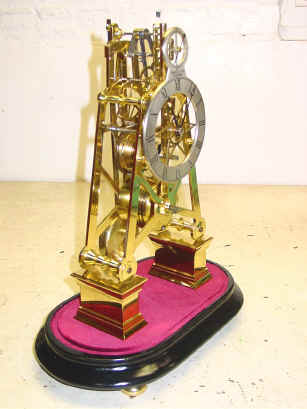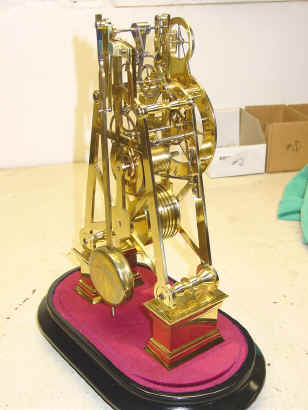Maker, Thwaites and Reed, London England, mid 1970's. 13.5"h x 7.5"w x 4.5"d / 18"h x 11"w x 6.5"d over dome. Rafter frame design, pinwheel with coup perdu (French for 'lost beat') escapement resulting in a seconds beating system, Harrison type maintaining power. Eight day duration. One of a limited edition of 100.




A coup perdu escapement converts a 1/2 second beating pendulum to directly control an escape wheel at the rate of a one second pendulum, so only every other beat is registered by the escape wheel. Hence the 'lost beat' moniker. It is an escapement with only one impulse pallet, the other being hinged to the escape anchor; allowing the escape tooth to pass without advancing the wheel. This design was invented by Jean-Baptiste Dutertre, France, c. 1720's. It is relatively rare for an English maker to use a pinwheel escapement. Note the complexity of the escapement, the many adjustment screws, the beat and depthing regulation system. Coup perdu escapements are, by their nature, more complex, but rarely reach this level intricacy. This is another classic design, first introduced in the mid 1800's and reproduced to the highest standards by this eminent maker.
This style is known as a 'rafter frame'. It is simple yet elegant and was a favorite for various makers to show off different types of escapements. It is suspected that many makers got their frames from the same supplier, but this is not known. The rafter frame design was copied in the Victorian era by Viner & Co., Dwerrihouse, Ogstan & Bell, Wray & Son and perhaps others. The various escapements used were, Graham deadbeat, and pinwheel with and without coup perdu feature. Some had beat regulation and /or depthing adjustment. But none incorporated both of these adjustments into the actual escapement as does this clock. Normally beat regulation was accomplished directly to the pendulum where it attached to the rear frame through the suspension bridge or where the crutch was attached. Click here for detail shots of the escapement and here for restoration shots.
Other sections of this site feature similar high quality reproductions made in the 1970's of classic Victorian designs. Click here: Congreve, Strutt.